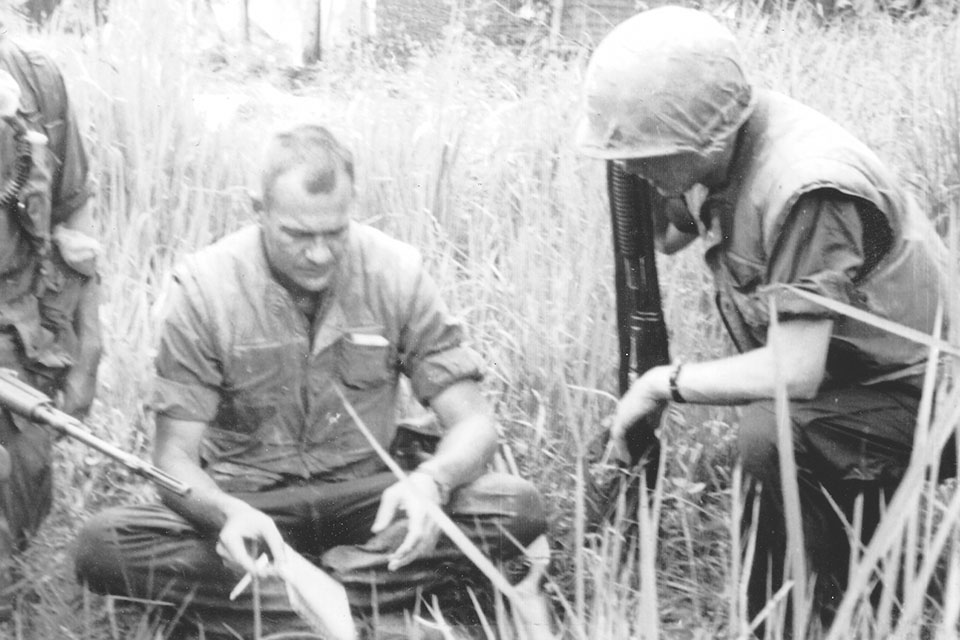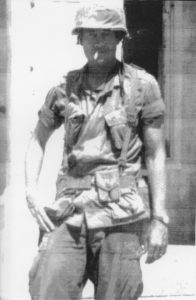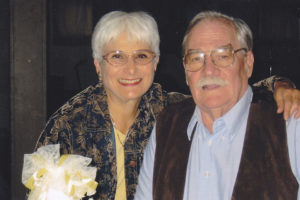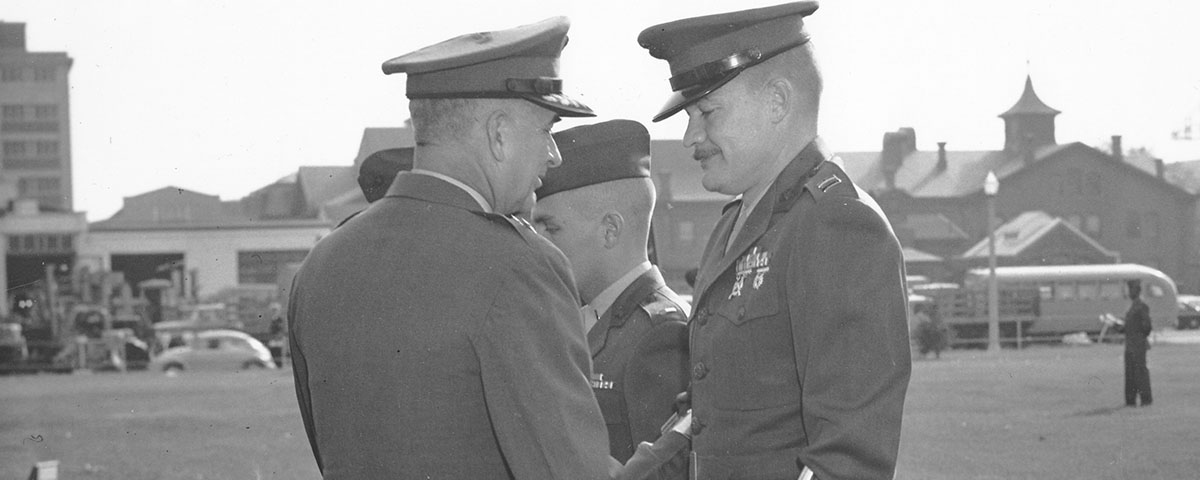A war correspondent recalls the bravery of a wounded Marine whom he covered.
As a reporter for United Press International, I covered several U.S. Marine Corps patrols targeting Viet Cong guerrillas, starting in early 1966.
But my first chance to witness a complex multi-battalion Marine operation came in late February 1967, when I covered Operation Stone in Quang Nam province in the northern part of South Vietnam.
The operation merits only brief mentions in the Marine Corps’ “Official Operational History Series,” but I’ll always remember it because of the brave leadership shown under fire by Marine company commander Capt. Bobby D. Lain.

As far as I could tell, the operation was largely successful, but it ended tragically for Lain when he lost his legs to a land mine. Although he’d been severely wounded, Lain kept commanding his company as his men closed in on a Viet Cong battalion. When an evacuation helicopter arrived to pick up Lain and other wounded Marines, the captain asked to be the last one put on the chopper.
I know all of this because I was standing next to Lain’s battalion commander, Lt. Col. Van D. Bell, when he was on the radio with the captain.
To put this in perspective, when Marines first landed in Vietnam in early 1965 they began fighting both Viet Cong guerrillas and VC main-force units. But once the Marines battered many of the main force units in 1965, the Communists sent North Vietnamese Army troops down the Ho Chi Minh Trail to bolster VC forces.
The Viet Cong main forces suffered a heavy beating in 1965 as a result of three major Marine operations: Starlite, Harvest Moon and Piranha.

During Operation Piranha, launched on Sept. 7, 1965, as a search-and-destroy follow-up to Starlite, the Marines coordinated with South Vietnamese troops to attack remnants of the 1st VC Regiment. The Viet Cong declined to fight, and the Marines found a large VC force holed up in a cave. The casualty toll was heavily lopsided in the Marines’ favor: Two Marines and five South Vietnamese were reported killed, while 183 Viet Cong were said to have died.
As a result of such operations, the Viet Cong main force units could no longer survive without heavy North Vietnamese manpower and support. The North Vietnamese began to backfill the Viet Cong losses in 1966 “and then began taking on the Marines as full-scale NVA units by the end of that year,” said retired Marine Lt. Col. Edward Nevgloski, a Vietnam expert at the Marine Corps History Division in Quantico, Virginia.
This meant that by early 1967, the Marines in Operation Stone faced much better trained and armed troops than the guerrilla fighters whom the Marines encountered after they arrived in Vietnam in 1965.
When covering an operation, I usually started by interviewing the battalion commander and then dropped down to the company or even platoon level to talk with the troops directly confronting the Viet Cong.
My first task in this case was to link up with Lt. Col. Van D. Bell. As the commander of the 1st Battalion, 1st Marine Regiment, Bell was known to many of us as “Ding Dong Bell,” a nickname that failed to do justice either to his professionalism or to a career that included a Navy Cross award for his heroism in the Korean War.
Bell, a cigar-puffing former all-Navy boxing champion, was popular among reporters and photographers because he always gave it to us straight. No B.S. No covering up bad news.
Operation Stone was in some ways a small part of a much larger 1st Marine Division effort to secure and hold territory in the provinces of Quang Nam, Quang Tin and Quang Ngai. As the Marine Corps Operational Histories Series explains it, in 1967 the Marines in these coastal provinces were undertaking both offensive military operations and pacification activities (which were intended to improve village security through social services that would make life better for the villagers). The enemy ranged from small groups of Viet Cong guerrillas in villages and hamlets to formations as large as an entire NVA division.
The three provinces were in an area that contained a large population, a major source of salt, and a rich basin for rice production. Mountains and foothills provided easy access for enemy infiltration. In the first six months of 1967, 1st Division Marines conducted 43 large-unit operations in the region, according to the Marine History Series. In addition, the division carried out more than 36,000 company-size operations, patrols and ambushes in the area.
The small-unit operations occasionally turned into hard-fought battles. On Jan. 31, 1967, a patrol by a company of the 2nd battalion, 1st Marines, came under fire from a main-force VC battalion near a hamlet less than 10 miles from Da Nang and were pinned down in exposed positions behind low rice paddy dikes throughout the day. Marine casualties numbered six dead and 26 wounded. The Marines estimated that they killed more than 100 Viet Cong.
The company commander, Capt. Edward J. Banks, requested air and artillery strikes on the enemy force, which may have deterred the Viet Cong but also contributed to civilian casualties. Over the next two days, local Vietnamese farmers brought 22 dead and 18 wounded villagers to the 2nd battalion’s command headquarters, according to the History Series. The battalion determined that these civilian casualties were a “regrettable corollary to the fighting on 31 January and 1 February,” according to the History Series.
The 1st Marines followed up the Jan. 31 action with Operation Stone. The operation began on Feb. 10, and on Feb. 19, Capt. Lain’s Bravo Company encountered a main force Viet Cong battalion. Bell, the Marine battalion commander, directed Bravo Company to close the last route of escape available to the enemy. Lain, according to a citation he received for heroism, was suffering from a foot wound caused by a punji stick. He refused evacuation. Lain then led his company through about 3 miles of heavily mined and booby-trapped terrain to surround and entrap the enemy battalion, which was reported to have suffered more than 250 casualties.
Marines were well aware of the dangers posed by mines and booby traps. In 1965, a year in which detailed statistics were available, some 65 to 70 percent of Marine Corps casualties were caused by mines and booby traps.
I once accompanied a platoon of Marines on a patrol 10 miles south of Da Nang. They showed me how to look for land mines and poison-tipped punji stakes. One Marine showed me how he walked in the footsteps of the man in front of him to lessen the chances of stepping on a mine. At one point, the Marines spotted a bamboo barrier blocking a path off the main road. Probably a booby trap. They blew it up with an explosive charge.
But in a fast-moving situation, where an officer is upfront with his troops and focused on closing in on the enemy, there is no time to study every feature of ground ahead of you. Lain was there, upfront with his men.
At that point, I had linked up with Bell. He was listening over the radio to what sounded like a developing success story for Lain’s Bravo Company. The captain was saying something like “we’re closing in fast.”
I know exactly what was said next because I still have a photocopy of the story that I wrote about Operation Stone nearly 51 years ago. It was published at the top of the front page in the World Journal Tribune, a New York newspaper that no longer exists.
Lain was calling to report the final closure on the Viet Cong battalion when Bell heard an explosion and an anguished cry.
“I’m sorry, Sir,” said Lain, fighting to regain composure. “I’ve lost my legs.”
Even in the midst of his tragedy, the Texas native spoke with a touch of Southern politeness.
But Lain wasn’t through. Before releasing the radio, he made sure the entrapment of the enemy force was complete. He then gave his final order, telling his men to keep firing. When an evacuation helicopter finally arrived, Lain said, “Put me on last.”
Tears welled in the eyes of Bell, a battle-hardened Marine officer as tough as they come.
I was told that I might be able to reach Lain if I followed a Marine sergeant who was headed that way. That required the sergeant to lead me through a mine field. I realized that we were taking a risk, but I wanted to see Lain at the scene.
By the time we reached the company’s location, Lain had been evacuated by helicopter. So I made my way back to Da Nang and met up with Lain at a Navy hospital there.
I found the captain with his hands and arms bandaged, but the Navy doctor, Lt. Cmdr. Norman Pollack, assured Lain they were all right.
“But I lost them down below, didn’t I?” Lain asked.
There was a pause, and then Lain calmly said, “Well, I guess I’ll go back to school.”
For his heroism in a difficult but successful operation and for other combat operations, Lain was awarded the Navy Cross and two Purple Hearts.

After returning from Vietnam, Lain, then 30, went back to school as he said he would. In 1974, he earned a doctoral degree in American history from the University of Texas in Austin. He then became a history professor at Austin Community College, where he taught non-traditional students.
Lain died on July 4, 2012, in Austin at the age of 75. He was survived by his wife Maxine and two sons.
Maxine said Lain never let the loss of his legs interfere with his life. He did roof repairs on his home. He built his own three-wheel motorcycle, which he and Maxine rode through Colorado and Canada’s East Coast provinces. He also participated in his sons’ football program.
At Austin Community College, “he was a fantastic, beloved teacher,” Maxine said. The college created an endowed scholarship in Lain’s name. At his insistence, it goes to older women who have decided to return to school.
Reporting the stories of Bobby Lain and many others, I learned that once you go home from covering a war, you’ll never be able to put it behind you. I tried that for many years, and it didn’t work. The best you can do is think about it, deal with it, and, if possible, write about it.
On the positive side, I feel privileged to have met Lain, if only briefly. In recent years, I thought of him many times as Veteran’s Day approached. Over time, I’ve come to realize that he was one of the most impressive people I had ever met during a career as a reporter and editor spanning more than five decades.
I’ve worked as a journalist in more than 40 countries, so I’ve obviously met many impressive people. But Lain would come out No. 1 or at least near that spot on my Top 10 list. He had survived a devastating land mine explosion and returned home to start an entirely new career that benefited many community college students.
This article was published in the March 2018 issue of Vietnam.





